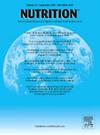Nutrient intake and fruit and vegetable offering in baby-led weaning compared with parent-led weaning in healthy 6- to 13-month-old infants: A systematic review and meta-analysis
IF 3.2
3区 医学
Q2 NUTRITION & DIETETICS
引用次数: 0
Abstract
Baby-led weaning (BLW) is an approach to complementary feeding that allows infants to self-feed solids. This method has grown in popularity, but its effects on eating behavior and nutrition are unclear. Systematically review and meta-analyses (SRMA) the evidence on the effects of BLW compared with parent-led spoon-feeding (PLW) on nutrient intake (NI), fruit and vegetable (FV) offering and FV intake for weaning infants aged 6–13 months. We followed the Cochrane and PRISMA guidelines to perform the SRMA and the GRADE approach to evaluate the evidence. The risk of bias of the cross-sectional studies was assessed via the Joanna Briggs Institute checklist. Meta-analyses were performed for NI and FV offering, using standardized mean differences and random-effects models. Six studies were included. At 6–10 months of age, BLW infants had significantly lower intake of free sugar and few micronutrients, which might be compensated for by breastfeeding. At the same age, a greater sodium intake was observed. No significant differences were found in nutrient intake for the 9–13-month-old group. Compared to PLW infants, BLW infants were offered 73% more vegetables in the youngest age group. There is great variability in the definition and characterization of BLW, which makes it difficult to derive clear conclusions. The evidence to date suggests that BLW does not imply a negative nutritional balance in the diets of children during complementary feeding; however, the certainty in this evidence is low. Further, more robust research should be conducted to gather more evidence.
6- 13个月健康婴儿在婴儿主导断奶与父母主导断奶时的营养摄入和水果蔬菜供应:一项系统回顾和荟萃分析
婴儿引导断奶(BLW)是一种辅助喂养方法,允许婴儿自行喂养固体食物。这种方法越来越受欢迎,但它对饮食行为和营养的影响尚不清楚。系统回顾和荟萃分析(SRMA)对6-13月龄断奶婴儿营养摄入(NI)、水果和蔬菜(FV)供应和FV摄入量的影响,并与父母主导的勺饲(PLW)进行比较。我们遵循Cochrane和PRISMA指南执行SRMA和GRADE方法来评估证据。横截面研究的偏倚风险通过乔安娜布里格斯研究所的检查表进行评估。采用标准化平均差异和随机效应模型对NI和FV进行meta分析。纳入了6项研究。在6-10个月大时,BLW婴儿的游离糖摄入量明显减少,微量营养素摄入量很少,这可能通过母乳喂养来弥补。在同一年龄,观察到更多的钠摄入量。9 - 13个月大的婴儿在营养摄入方面没有发现显著差异。与PLW婴儿相比,BLW婴儿在最年轻的年龄组中获得的蔬菜多73%。BLW的定义和特征有很大的差异,这使得很难得出明确的结论。迄今为止的证据表明,BLW并不意味着补充喂养期间儿童饮食中的负营养平衡;然而,这一证据的确定性很低。此外,应该进行更有力的研究来收集更多的证据。
本文章由计算机程序翻译,如有差异,请以英文原文为准。
求助全文
约1分钟内获得全文
求助全文
来源期刊

Nutrition
医学-营养学
CiteScore
7.80
自引率
2.30%
发文量
300
审稿时长
60 days
期刊介绍:
Nutrition has an open access mirror journal Nutrition: X, sharing the same aims and scope, editorial team, submission system and rigorous peer review.
Founded by Michael M. Meguid in the early 1980''s, Nutrition presents advances in nutrition research and science, informs its readers on new and advancing technologies and data in clinical nutrition practice, encourages the application of outcomes research and meta-analyses to problems in patient-related nutrition; and seeks to help clarify and set the research, policy and practice agenda for nutrition science to enhance human well-being in the years ahead.
 求助内容:
求助内容: 应助结果提醒方式:
应助结果提醒方式:


